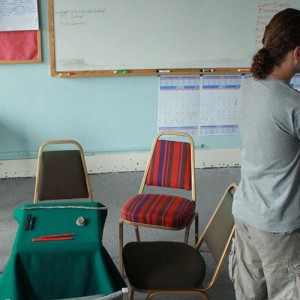47 minutes and 48 seconds.
Evan Gardner and Willem Larsen discuss (once again, while on the road to the June Vancouver, B.C. “Save Your Language” Conference”) issues of building fluency, over proficiency, by making technique use more complex, rather than language use. WARNING: this podcast contains some mildly off-color humor of possibly the third grade level, or lower. This is for a specific functional purpose, but if you are easily offended by toilet humor, you may wish to pass on this particular podcast. You have been warned. And if we at WAYK ever successfully seemed professional, this unfortunately will undo a lot of that careful image-building. Oh, well: it’s all for a good cause, folks.
1. Technique “Fluency”
- Fluency means Flow.
- Mihaly Czikszentmihalyi and Flow.
- If play is too simple, you become bored, if it’s too complex, you become overwhelmed.
- Your goal is to continually adjust the level of play into accord with your experience of flow.
- Willem tells a story of someone who wanted to increasing the complexity of their play experience (and thus reattain flow) by choosing to play with an object that was not obvious or limited. This would prevent them from achieving that flow state, in spite of their best efforts.
- Rather than increasing complexity of topics (nouns, objects, etc.), increase complexity of language structure itself, and the variety and layering of language hunting techniques.
2. Technique “Squatter’s Rights”
3. Technique “Accordion”
- How do you stay at the level of the edge of your fluent proficiency, so that you can build fluency, for as long as possible?
- You will get bored of before you’re ready to move on.
4. Technique “Can I Help You?”
- Evan: If someone, in a foreign speech environment, walks up to you and says “can I help you?”, say “yes!”. It may save your life.
5. Technique “Glad, Sad, Mad”
- Stretch out/accordion a conversation by incorporating different feelings and attitudes.
6. Technique “Overdo It”
- Peter extends his ability to stay in a target language conversation by getting really, really silly.
- This reveals new layers of “full” – once you get more experienced, you can keep playing even when initially “exhausted”, by discovering new reservoirs of energy.
- Sometimes the limited availability of a fluent fool means you have to extend your ability to delay getting “full”.
7. Technique “Potty Mouth”
- Creating off-color language will extend play for many people.
8. Technique “Dog Track”
- Anything that gets you playfully running over the same ground, over and over, is an accelerator.
9. Technique “Potty Mouth”
- Willem describes some of the poopy talk that he engages in in Chinuk.
- Taboo subjects make language easier to remember. Honest.
10. Technique “Link, Peg, Loci”
- The art of creating evocative mnemonic associations for new language structure.






Is “Paper Face” a WAYK Technique, a common ASL idiom, or both?
I find the whole-body expression of ASL to be one of the most enjoyable things about signing. I wouldn’t want to give it up!
With a new sign or signing phrase, my true feeling is “I wonder if I’m doing this right” or something, so that’s the expression on my face: mild confusion. It takes fluency express something else.
Jay,
“Paper face” is an ASL expression. It is something that inexperienced signers do that totally maddens fluent signers.